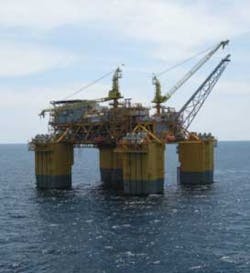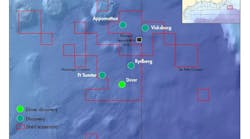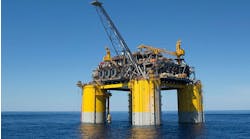The 2009 Deep Offshore Technology International Conference and Exhibit, held Nov. 3-5 at the Grimaldi Forum in Monaco, brought together more than 1,100 oil and gas professionals from 48 countries with a common interest in the conference theme of “Rising to the Deepwater Challenges.” Since its inception 29 years ago, DOT has been held annually on five different continents, collectively attracting more than 30,000 attendees over its tenure.
A special event at this year’s DOT was a visit by His Highness Prince Albert of Monaco in Monte Carlo. Prince Albert’s presence underscored the importance of the event to the deepwater offshore industry and commemorated the event’s return to Monte Carlo after its initial launch in 1980.
“We were honored today by H.H. Prince Albert’s visit to the event and are proud of the event’s great success this week in Monte Carlo,” said Robert Biolchini, president and CEO of Tulsa-based PennWell. “Deep Offshore Technology’s conference program is an important platform for industry leaders to come together to exchange information, present new solutions, and discuss future developments most critical to the growth of the market. Conference sessions were at capacity with professionals discussing the substantial issues surrounding deepwater exploration and production and how future demands can be met.”
Prince Albert’s visit to the event included a tour of the exhibition floor, which showcased more than 40 exhibiting companies displaying the latest products, technologies, and services. His Highness’ visit was a closing highlight of the show.
Sponsors of this year’s DOT International were Total, Technip, Bennett & Associates, Cameron, INTECSEA, SBM Offshore, Oil States Industries, ABS, GEP, International Dynamic Positioning Operators Association (IDPOA), and Subsea UK.
Opening speakers
The keynote for the opening session of DOT was Frederic Garnaud, R&D program manager, surface technologies, Total E&P, who looked at project costs.
“Project costs must reflect the current economic environment,” he said. “We have to optimize the design of our projects and review our contract terms,” warning that some projects may have to be postponed if costs do not decrease.
Projects are changing, he said. They are larger, more complex, and more capital intensive, with more interfaces. Project capex runs in the range of $6-8 billion with some reaching to $15 billion. Therefore, “we need to develop more project management capability and competent staff,” Garnaud said.
Garnaud pointed to subsea processing as one growing trend offshore, but said that the technical challenges of subsea separation must be considered, and that the next challenge is to bring the costs down to reflect the current economic environment. Another trend he sees is subsea tieback of smaller fields.
Gernaud said Total’s next deepwater development to get sanctioned will be Clov, which is expected in the coming months. The proposed development scheme is based on a spread moored FPSO, MPP, gas export, and 34 subsea wells.
A design competition has been launched, he said, to get engineering contractors to bring more technical and cost-effective solutions to the table.
The potential field development plan for Clov is becoming a standard of the company’s deepwater projects, he added. Clov is in block 17 offshore Angola and comprises Cravo, Lirio, Orquidea, and Violeta discoveries
Looking at offshore activity from now to 2016, John Westwood told the conference that the world will increasingly rely on offshore and deepwater production and that the total offshore spend is forecast to grow from $260 billion in 2008 to $360 billion in 2013.
Oil production from deepwater, one of the cheapest sources of liquid fuels, Westwood said, is expected to exceed 10 MMb/d by 2015. Deepwater wells will account for 61% of total wells by 2015, and the deepwater FPS market is estimated to be $30 billion over the period 2010-2014. Meanwhile, Westwood forecasts the FLNG sector will grow to about $23 billion over the period 2010-2016.
From one contractor’s perspective, the FPSO outlook is improving for 2010. Tony Mace, CEO of SBM Offshore said there is potential for five total FPSO awards by the end of this year, which is up from zero during the previous year or so. About 78 FPSO projects are possible in the next 5-10 years, with 50% of them in Brazil, Nigeria, and Angola.
One challenge in these countries is the requirement for increasing local content, Mace said. Petrobras in a recent tender is targeting 65% local content, he said. This is one factor driving up the price of projects while shipyard, supplier, and contractor pricing is coming down.
Another trend is increasing water depth per FPSO. This is expected to increase with the pre-salt discoveries. One technical challenge is the development of cost-effective risers for greater than 2,000 m (6,562 ft) water depth, Mace said. Another technical challenge is development of a swivel system to handle 800 bar for high temperature/high pressure fields. This is currently under development, he told the opening plenary attendees.
Remote deepwater gas fields pose problems as well, he added, pointing to FLNG as a technically viable solution. Development is under way on gas export via FLNG on the Tupi field offshore Brazil, for instance.
One more trend is to more leased FPSOs, Mace said. By 2010, he expects for the first time leased FPSOs will exceed the number of oil company owned vessels.
Technical sessions
Technical presentations for DOT in Monaco were divided into three tracks. The tracks were:
- 1. Floating production systems, mooring and station keeping, and project management
- 2. Subsea technology, subsea boosting and processing, and flowlines and pipelines
- 3. Field development/lessons learned, well construction, asset management, and flow assurance.
Following are a selection of technical papers presented at DOT:
An overview of the Thunder Hawk deep draft semi FPU
SBM Atlantia (SBMA) and Murphy Exploration & Production Co. presented an overview of theThunder Hawk deep draft semisubmersible floating production unit currently deployed in deepwater in the Gulf of Mexico. The authors of the paper were Steve Leverette and Dwayne Breaux of SBMA, and Paul Fourchy of Murphy.
TheThunder Hawk facility was installed offshore Louisiana in Mississippi Canyon (MC) 736 in 6,060 ft (1,847 m) of water, and is producing from the Thunder Hawk field in MC 734. Thunder Hawk is the second of SBMA’s DeepDraft Semi Floating Production Units (FPU).
The scope of the project included providing full engineering, procurement, construction, and installation (EPCI) services for the topsides, hull, moorings, riser design, installation, and offshore commissioning. The Thunder Hawk project is the first Production Handling Agreement (PHA) for the SBM Offshore Group. First oil was achieved on July 8, 2009.
The facility is anchored with a polyester spread mooring system and is connected to the subsea manifolds and infrastructure with steel catenary riser (SCR) flowlines, SCR export risers, and multiple control umbilicals. Provisions have been made to accommodate future subsea tiebacks and associated production from other fields/blocks in the area, including processing production from third party producers.
Unique project components include accommodation of increased GoM metocean criteria to an earlier hull design, development of new hydrodynamic modeling techniques for VIM of the hull during the design, fabrication of the hull in a module fabrication yard which included two new panel lines and additional quayside development during the project schedule, and record-setting achievement of “quarters habitable” status of the hull only two months after initial deck lift during quayside integration.
SBM Atlantia and SBM GustoMSC previously teamed to supply the world’s first DeepDraft Semi for Enterprise Products Partners’ Independence Hub project in a record setting 8,050 ft (2,454 m) water depth in MC 920.
According to the authors, the DeepDraft Semi is establishing itself as a workhorse for oil companies exploring and developing fields in the ultra deep waters of the GoM. TheThunder Hawk FPU was one of the first deepwater projects to address the new GoM environmental criteria which evolved from the Ivan, Katrina, and Rita hurricane experiences. SBM worked with the API in developing the new design guidelines, which MMS has now made into regulation, and worked with Murphy to interpret the regulations and to develop site-specific environmental criteria for the Thunder Hawk development. SBM also helped develop the wave slam load methodologies used in this project.
A key feature of the facility is its low motion characteristics to accommodate the requirements of SCR flowlines and risers in a cost-effective manner compared to other FPU concepts. The other significant advantage is the system’s ability to mate the topsides deck to the hull at quayside, thereby avoiding costly offshore lifting and system commissioning operations. By integrating the topsides onto the hull at quayside, the FPU can be fully pre-commissioned and USCG “quarters habitable” permits can be obtained prior to mobilizing the facility offshore – thus, reducing costly, labor intensive offshore commissioning activities.
During the concept definition phase for the Thunder Hawk development, it became evident that hull fabrication in the “traditional” hull construction yards was going to be a risk due to the limited spare global construction capacity. The decision was made to develop a new hull fabrication site at the Dyna-Mac yard in Singapore, a topsides module fabricator. This bold move required a “green-field” development of the existing yard facilities to include panel lines, new craneage, transporters, covered fabrication areas, quayside, and high load capacity assembly areas. The timing was aggressive, and required that the fabrication yard construction be performed during the hull design. The hull fabrication began as soon as the first panel line was complete.
TheThunder Hawk FPU is SBM’s first lease unit in the GoM, but part of its worldwide fleet. SBM is working with Murphy on other fields around the world and anticipates additional cooperation in the future.
High-pressure, multi-phase subsea pumps enable deeper water production
A joint industry project (JIP) on pumps has developed technology that generates a higher differential pressure for ultra deepwaters, longer tiebacks, and high-boost dependent fields. Arne Olsen of Framo Engineering described the results of the High Boost Multiphase Pump Project. Project participants included Shell, Total, StatoilHydro, and BP.
Started two years ago, the JIP has successfully designed, manufactured, and tested a subsea pump that increases the differential pressure capability by a factor of three to four, according to Olsen.
The high-boost pump is based on proven hydraulic, mechanical, and electrical component designs currently used in conventional pumps. The new pump, however, can generate a differential pressure of up to 200 bar (20 MPa) to enable developments in water depths ranging from 2,000 m to 3,000 m (6,562 ft to 9,842 ft).
Combining these proven pieces with a novel thrust balancing technology is the key to the increase in boost. Comparing a convention pump unit to the high-boost unit shows that both can reach high volume flow rates around 300,000 boe/d, but that the high-boost version does so at up to four times the differential pressure of the conventional unit.
The Framo report says that high-boost pumps are available commercially and similar units are functioning in field installations around the world. More than 20 pumps of the design are operating and collectively have more than 900,000 accumulated run hours.
Ultra high-pressure risers for deepwater drilling
Deepwater development requires increasing attention to riser system design, given the challenges of water and well depth. According to a presentation by Karim Jan, Simon Luffrum, John Shields, and Paul Brett of SRP, one solution is a technique of fabrication using shrink-fitting that allows higher grade materials to be used and eliminates the problems associated with welding thick walled pipes.
For many years shrink-fitting has been a standard connection method whereby a shaft is inserted into a pre-heated female component which is then left to cool. Although common in many industries, its use in the offshore oil and gas industry is limited. Welding and threading are the connection methods of choice to this day. The company’s DOT presentation covered the development, testing, and manufacture of a full-bore (19-in. internal diameter) shrink-fit riser connection for a high pressure drilling system with a surface BOP.
The team described the methods used and the value gained from such a system. They also discussed the applicability of the system already constructed for a North Sea application to deepwater systems in which high strength steels of 110 ksi and beyond might be employed. The shrink-fit connection and riser system was developed in response to the challenge of drilling a shallow water, sour, high pressure subsea tieback in the most cost-effective manner.
A key aspect of this challenge was the maximum predicted shut-in tubing head pressure of the development: approximately 11,000 psi. Ultra high pressure wells have typically been drilled using a subsea BOP, low pressure marine drilling riser, and semisubmersible drilling rig. However in this instance a jackup drilling rig was selected and with a strong preference to maintain a full bore riser with surface BOP. This arrangement allowed cost benefits to be achieved on the rig rates but placed a number of challenges on the riser system.
The preliminary design and analysis of the riser system indicated that a solution could be achieved with a 19.5-in. (50-cm) bore riser with a 2 in. (5 cm) wall thickness using a relatively high strength steel (80 ksi). However, it was recognized that manufacturing such pipe and fabricating riser joints would be a significant challenge if NACE requirements are to be achieved, and this represented a significant commercial and schedule risk. Therefore the option to use a new shrink fit solution was seriously considered by the project and ultimately qualified and selected in preference to the welded route.
The authors found that the excellent fatigue performance of the shrink-fit connection lends itself well to riser joints, bend stiffeners, and other fatigue critical services. SRP is developing a low-profile shrink-fit sleeve to enable construction of joints up to 30 m (98 ft) long for deepwater drilling applications. Extensive FE analysis of a sleeve design has already been carried out, and the results show that a sleeve coupling with a wall thickness comparable to the pipe would be feasible. In deepwater applications, high strength steels of 125 ksi minimum yield strength or greater may be used with the shrink-fit technique to minimize riser weight.
In critical locations along the riser length, forged taper joints are often required to control bending and fatigue. The use of shrink-fit flanges or connections allows equivalent fatigue performance to be achieved using “fabricated” joints. This greatly simplifies the procurement process reducing cost and shortening schedule. Of particular interest is the possibility of shrink fitting a steel flange onto a titanium pipe. This allows the designer to take benefit from the titanium properties without the cost and complexity of the titanium connector that must either be forged integrally or connected through a welding process that degrades the fatigue performance, the presenters said.
Editor’s note: For more information online, see the following: http://www.offshore-mag.com/index/article-display/4434277676/articles/enl/dot-video_recap.html, http://www.deepoffshoretechnology.com/index.html.







